Introduction
In today’s fast-paced and highly competitive business landscape, efficient order fulfillment is critical. Salesforce Dynamic Revenue Orchestrator (DRO) is a comprehensive solution designed to streamline complex order management processes, ensuring orders are fulfilled with precision and speed. By breaking down orders into manageable components, automating fulfillment steps, and proactively handling potential risks and failures, DRO empowers businesses to maintain seamless operations. This blog explores the key features, architecture, and benefits of DRO, illustrating how it transforms order fulfillment into a flexible and efficient process while keeping customer satisfaction at the forefront.
Salesforce Dynamic Revenue Orchestrator (DRO)
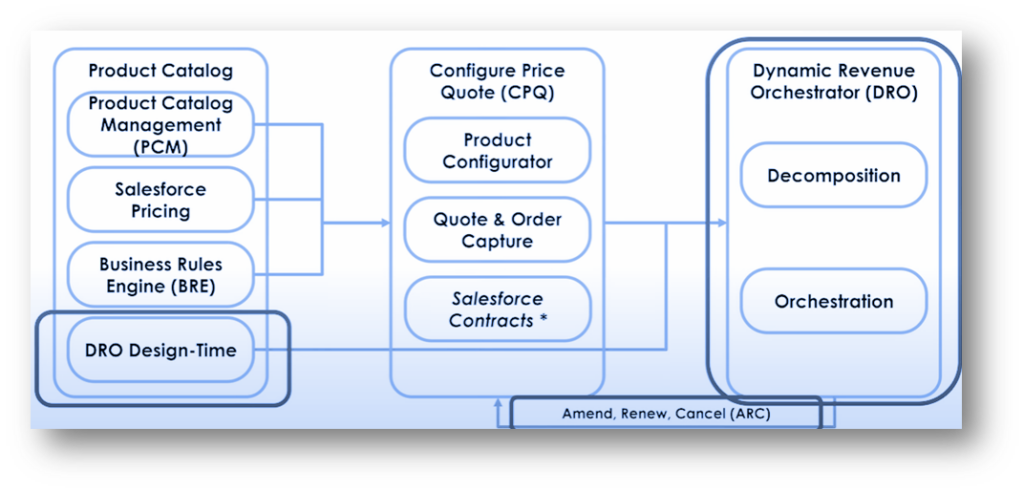
Transforming complex order processes with flexibility & efficiency.
What is DRO?
DRO (Decomposition and Orchestration) is a powerful tool designed to help businesses efficiently manage and streamline complex order processes. By breaking down intricate workflows and automating coordination, DRO ensures smooth and efficient operations, even in the most demanding environments.
Functional Architecture
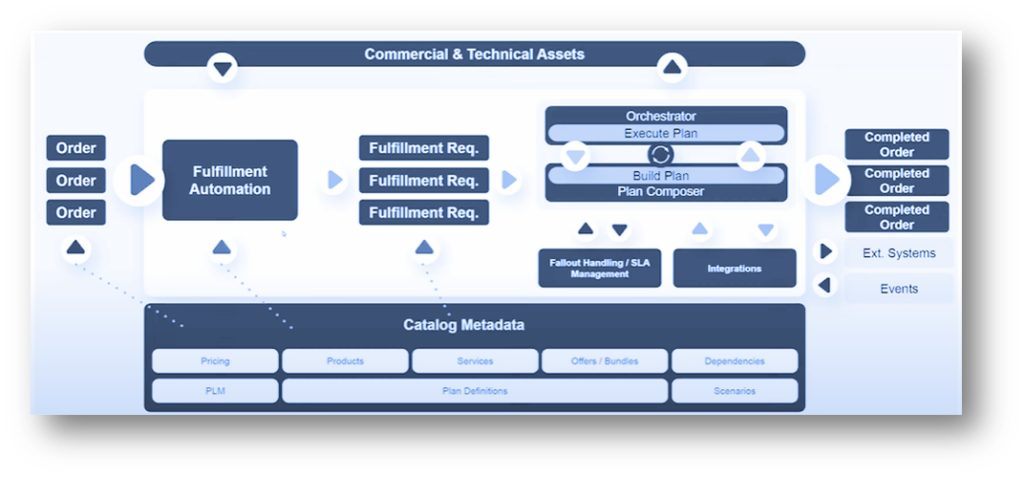
Key Features of DRO
- Decomposition
DRO enables businesses to decompose products and order lines into manageable components. This breakdown allows for the application of custom fulfillment plans tailored to each product or order line, optimizing the entire fulfillment process. - Orchestration
With DRO, companies can seamlessly coordinate complex workflows. The tool ensures that all moving parts of order fulfillment work harmoniously, enhancing operational efficiency and minimizing delays. - Jeopardy Management
Stay ahead of potential risks with DRO’s jeopardy management feature. It monitors for issues that could impact order fulfillment, allowing teams to proactively address and resolve concerns before they escalate. - Fallout Management
Maintaining continuity in operations is crucial. DRO efficiently handles exceptions and failures through robust fallout management, ensuring that disruptions are minimized and operations remain on track.
DRO transforms how businesses manage order fulfillment, offering a structured and proactive approach to handle the complexities of modern order orchestration.
Prerequisites for DRO
1.Go to setup – Quick Find box – Dynamic revenue orchestrator setting – enable it.
2.Turn on features to manage fallout and service level agreements.
What is Decomposition?
Decomposition is the process of breaking down a customer order into smaller, manageable steps. This breakdown occurs as the order is submitted, using specific rules and mappings that ensure each component is handled efficiently.
Example of Decomposition
Imagine a customer placing an order for a new laptop. Decomposition would break this order into various tasks, such as:
- Shipping the laptop
- Installing pre-loaded software
- Setting up warranty services, and more.
Each of these steps is managed separately to streamline the fulfillment process.
Role Of the Fulfillment Designer
The Fulfillment Designer plays a crucial role in configuring how commercial products (the items visible to customers) decompose into backend fulfillment tasks (the processes not visible to customers). By defining these rules and mappings, the Fulfillment Designer ensures seamless order handling and efficient operations.
Configuring Decomposition
Product Decomposition Rules
Define Product Decomposition Rules
Set up rules that control how a commercial product breaks down into technical products. These rules are crucial for ensuring the accurate transformation of a commercial product into its technical components in the fulfillment process.
Define priorities and conditions for these decomposition rules to ensure that the breakdown aligns with business needs and technical specifications.
Create Conditions for a Decomposition Rule
Set up “Execute On” rules, which specify when a decomposition rule should run during the fulfillment process.
These conditions can be based on various criteria such as product attributes, order characteristics, or timing, helping to control the precise moment when the decomposition rule should be applied.
Field and Attribute Mapping
Define how data from customer orders is transformed into data needed for backend fulfillment systems.
This mapping ensures that customer-facing data (commercial) is properly translated into technical data required by internal systems to execute the fulfillment process.
Dynamic Revenue Orchestrator (DRO) handles this mapping, ensuring accuracy and consistency between commercial and technical data.
Configure List Mapping
Create source-destination pairs (e.g., city and post code) to specify how data should be mapped between different systems.
When the source data matches a condition, the correct value is assigned to the target field. This mapping is critical for ensuring that data is accurately transferred between systems during the order fulfillment process.

Product Decomposition Rules
Define Product Decomposition Rules
1. Set up rules that control how a commercial product breaks down into technical products. These rules are crucial for ensuring the accurate transformation of a commercial product into its technical components in the fulfillment process.
2. Define priorities and conditions for these decomposition rules to ensure that the breakdown aligns with business needs and technical specifications.
Create Conditions for a Decomposition Rule
1.Set up “Execute On” rules, which specify when a decomposition rule should run during the fulfillment process.
2.These conditions can be based on various criteria such as product attributes, order characteristics, or timing, helping to control the precise moment when the decomposition rule should be applied.
Field and Attribute Mapping
1.Define how data from customer orders is transformed into data needed for backend fulfillment systems.
2.This mapping ensures that customer-facing data (commercial) is properly translated into technical data required by internal systems to execute the fulfillment process.
3.Dynamic Revenue Orchestrator (DRO) handles this mapping, ensuring accuracy and consistency between commercial and technical data.
Configure List Mapping
1.Create source-destination pairs (e.g., city and post code) to specify how data should be mapped between different systems.
2.When the source data matches a condition, the correct value is assigned to the target field. This mapping is critical for ensuring that data is accurately transferred between systems during the order fulfillment process.
Decomposition Scopes
1.Order Line Item (Default):-One instance of the fulfillment order line item is created for each order line item that decomposes to it.
2.Order:-A single instance of the fulfillment order line item is created per order, regardless of how many products require the same technical product.
3.Bundle:-A new instance of the fulfillment order line item is created per bundle within an order.
4.Account :-A single instance of the fulfillment order line item is created across all orders from the same account.


Fulfillment Designer
1.After Decomposition:Once order items are decomposed, the Dynamic Revenue Orchestrator (DRO) creates the steps required for fulfillment.
2.Fulfillment Designer:Defines fulfillment steps, dependencies, and rules before the order is submitted.
Ensures the correct sequence and conditions for the fulfillment steps.
Key Concepts in Fulfillment Design:
1.Fulfillment Steps: Individual tasks that need to be completed to fulfill an order.
2.Dependencies: Logical connections between steps to determine their execution order.
3.Conditions: Rules that control when steps start, pause, or resume during the fulfillment process.
Fulfillment Designer & Step Groups
Create a Fulfillment Workspace
1.A central hub to organize fulfillment steps, dependencies, and other processes.
2.Allows better management and visualization of the entire fulfillment process.
Create a Fulfillment Step Definition Group
1.Logical and reusable groupings of fulfillment steps.
2.Can be managed directly from the workspace.
Define Product Fulfillment Scenario(s)
1.Link your Fulfillment Step Definition Groups to Commercial or Technical Products.
2.Define Actions to enable different fulfillment processes for newly ordered products versus different ARC scenarios.
Import a Fulfillment Step Definition Group
1.Bring existing step definitions into the workspace for reuse across multiple orders.
2.Encourages consistency and efficiency.
Add a Fulfillment Step Definition to a Group
1.Organize individual steps within a group for better monitoring and execution.
2.Helps track steps during runtime.
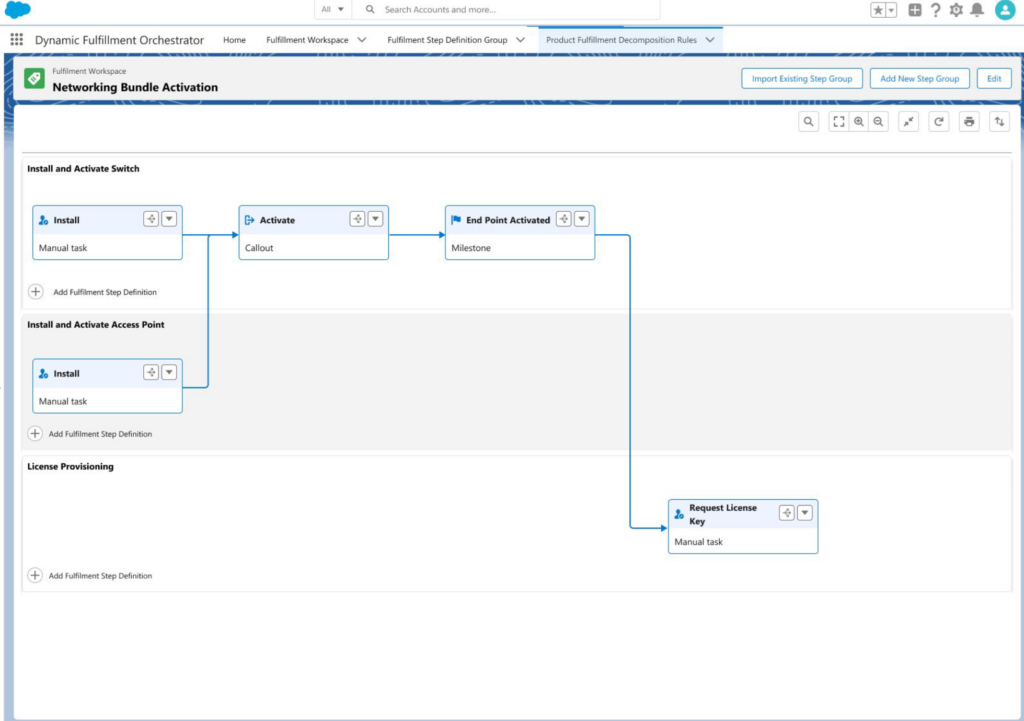
Fulfillment Step Configuration.
Define a Fulfillment Step
- Create specific steps based on fulfillment needs.
- DRO uses these steps to create a Fulfillment Plan when an order is submitted.
Set Dependencies Between Fulfillment Steps
- Graphically connect steps to create dependencies.
- Steps run in the order defined by these dependencies.
Define Conditions for Steps
- Control when a step runs, such as waiting for dependent steps to complete.
- Set conditions for steps to Start, Pause, or Resume.
Avoid Dependency Loops
- Avoid creating loops in the dependency graph, where a step depends on itself or forms a cycle, causing logical errors in the execution.


Fulfillment Task Type
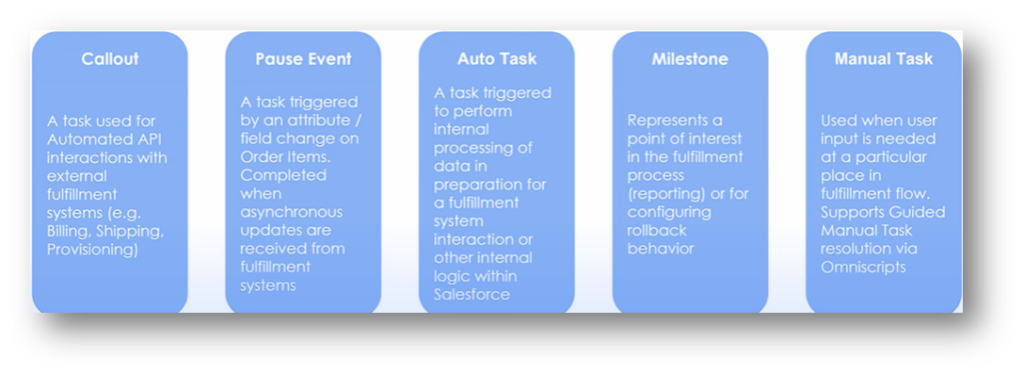
Fulfillment Step Scope
Purpose of Scope in Fulfillment Steps
- The scope of a fulfillment step controls how many times the step is created during fulfillment.
- This helps manage situations where multiple products in an order require the same fulfillment step.
Available Scopes for Fulfillment Steps
- Plan
- One instance of the step is created for the entire fulfillment plan.
- Example: Only one Confirm Service step is created, no matter how many products require it.
- Bundle
- One instance of the step is created per bundle.
- Example: If products are grouped in bundles, a Confirm Service step is created for each bundle.
- Line Item
- One instance of the step is created for each line item.
- Example: Each product (e.g., cable channel and internet) triggers its own Confirm Service step.



SLA Jeopardy Configuration
Jeopardy
- Configure alerts and settings to handle fulfillment steps that are delayed or at risk of not finishing on time.
- Estimated Duration
- Defines how long a fulfillment step is expected to take.
- Example: Let’s say there’s a manual task to check the credit of a customer. You set the Estimated Duration to 3 hours. Then you set the Jeopardy Threshold to 30 minutes. If the task is not completed within 2.5 hours after it starts, the task is considered in jeopardy.
- Jeopardy Threshold
- Sets a warning period before a step becomes late.
- Example: If the Estimated Duration is 100 minutes and the Jeopardy Threshold is 10 minutes, the step is flagged as in jeopardy after 90 minutes.
Fallout Configuration
Fallout
- Define how Dynamic Revenue Orchestrator (DRO) handles failures in auto tasks or callouts, ensuring smooth fulfillment even when errors occur.
Key Concepts
- Fallout Rules
- Determine what happens when a fulfillment step fails.
- Example: Set a rule to retry a callout with error code 402 up to 3 times, then assign it to a queue if it still fails.
- Customizable Failure Handling
- Define specific rules for each step or task that may fail.
- Example: Assign different rules based on integration definitions and error codes.
Example Scenario
1.Fallout Rule #1 specifies an integration definition, WareHousePull, but doesn’t specify an error code.
2.Fallout Rule #2 specifies the same integration definition and error code 2112.
- Callouts with the integration definition WareHousePull that receive any error code except 2112 use rule #1.
- Only the callouts that use the integration definition WareHousePull and receive error code 2112 use rule #2.
Run Time Monitoring
Key Monitoring Tools
- Decomposition Viewer
- Enables operators to monitor how products decompose into technical steps during fulfillment.
- Provides real-time insights into potential issues with decomposition, allowing for quick intervention.
- Fulfillment Plan
- A graphical interface displaying each fulfillment step, its status, and the dependencies between steps.
- Helps operators visually track the progress of order fulfillment and identify bottlenecks or delays.
Key Benefits
- Real-time monitoring allows operators to track the decomposition and fulfillment process as it happens.
- Quickly spot issues in product orchestration and take action to ensure smooth order completion.
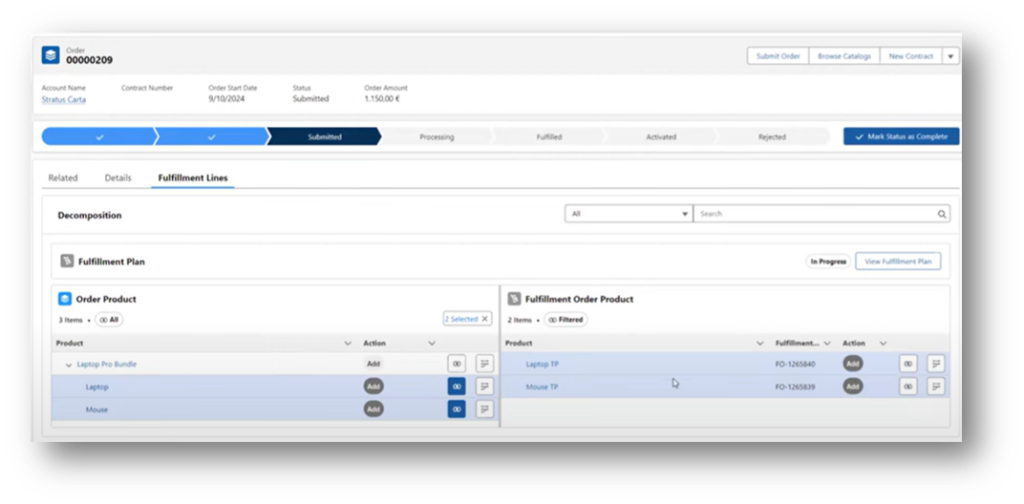
Key Features
- View and Manage Fulfillment Steps
- The Fulfillment Plan shows each step as it progresses through the fulfillment pipeline.
- Operators can view the status of steps, track dependencies, and manage issues directly from the plan.
- Fulfillment Plan Actions
- Take action directly from the plan: Pause, resume, or retry steps based on fulfillment progress.
- Gain deeper insights by reviewing details about individual steps and understanding the broader fulfillment process.
- Bulk Retry or Complete Failed Steps
- From a list view or queue, operators can retry or complete multiple failed fulfillment steps simultaneously.
- This saves time by allowing operators to handle several failed steps at once.
- Bulk completion bypasses errors that might otherwise prevent a step from completing, ensuring that fulfillment continues smoothly.
Conclusion
Salesforce Dynamic Revenue Orchestrator (DRO) revolutionizes the way businesses handle complex order fulfillment processes. By leveraging its core functionalities—such as decomposition, orchestration, jeopardy management, and fallout handling—DRO ensures a streamlined, efficient, and reliable approach to order fulfillment. The Fulfillment Designer empowers teams to create and manage intricate workflows, monitor progress in real time, and promptly address potential risks or errors. With DRO, companies can optimize operational efficiency, proactively manage delays, and maintain smooth, uninterrupted service even in challenging scenarios. Embracing DRO means equipping your business with a robust, scalable solution for modern order orchestration and fulfillment.

